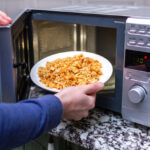1. Thawing in the Fridge
Place the frozen ground beef in a deep dish to catch any drippings and transfer it to the refrigerator a day before cooking. This is the slowest but safest method as the meat stays at a consistently cold temperature. If thawed this way, the ground beef can be kept in the fridge for 24-48 hours before cooking.

Before cooking, inspect the ground beef. Using clean hands, gently press down on the package. If there is a slight indentation, most of the meat has thawed and is ready for cooking. For further confirmation, halve the meat and press down on the center. If it feels soft, it has fully thawed; if there are still hard spots, it needs more time.
If you’re in a hurry, you can continue thawing in the microwave for a few minutes.
2. Water Thawing
For every 450g package of ground beef, allow about 60 minutes for water thawing. Start this process at least an hour before cooking, if possible. Larger packages will take longer; for instance, 1.4-1.8kg of ground beef will take 2-3 hours.
Very small packages (less than 1 cm thick) may take a minimum of 10-20 minutes. Here’s how to do it:
– Place the ground beef in a ziploc bag and seal it securely. A leak could introduce bacteria and cause the meat to become waterlogged.
– Put the bag in a large bowl and cover it with cold water. Ensure the meat is fully submerged. Use only cold water; hot, warm, or room-temperature water can promote bacterial growth. If your tap water is too warm, add an ice cube or two to cool it down slightly.

Alternatively, you can fill your sink with cold water and submerge the meat. Make sure your sink is clean and the drain is tightly closed before starting.
Note: Change the water every 30 minutes. Drain the used water and refill the bowl with cold, fresh water. This helps keep the meat thawing while inhibiting bacterial growth. Ensure the water stays cool; add more ice if needed.
After an hour, check the meat. Press it with a clean finger; if it feels soft, it’s fully thawed. You can also halve the meat and press the center; if it’s still hard, the center is not yet thawed.
To prevent bacterial growth, ground beef thawed using this method must be used within 2 hours. If you need to wait longer before cooking, store it in the fridge after thawing.
Meat thawed in cold water is more susceptible to bacterial growth and should not be refrozen. If you can’t use it within two hours, it’s best to cook it and then freeze the cooked meat.
3. Microwave Thawing
You can also use your microwave for a quicker, more convenient thawing process. Place the unwrapped ground beef in a deep dish and put it in the microwave on medium power. Start with 3 minutes per 450g of meat. Using medium power instead of high power prevents the meat from cooking prematurely.
The Ultimate Hack to Revive Leftover Rice: A Sprinkle of Magic
When reheating rice in the microwave, there’s a simple trick to ensure it doesn’t dry out and become hard. By adding a small amount of water and covering the bowl, you can retain the moisture and fluffiness of freshly cooked rice. This method ensures your rice is not only warm but also delicious and fragrant.




































